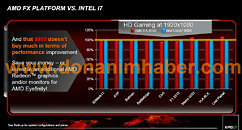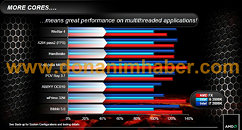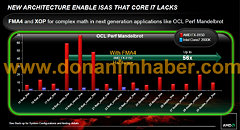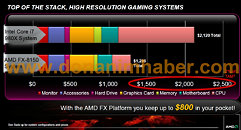Saturday, September 24th 2011

AMD FX 8150 Looks Core i7-980X and Core i7 2600K in the Eye: AMD Benchmarks
The bets are off, it looks like Intel is in for a price-performance shock with AMD's Bulldozer, after all. In the press deck of AMD FX Processor series leaked by DonanimHaber ahead of its launch, AMD claims huge performance leads over Intel. To sum it up, AMD claims that its AMD FX 8150 processor is looking Intel's Core i7-980X in the eye in game tests, even edging past it in some DirectX 11 titles.
It is performing on par with the Core i7-2600K in several popular CPU benchmarks such as WinRAR 4, X.264 pass 2, Handbrake, 7Zip, POV Ray 3.7, ABBYY OCR, wPrime 32M, and Bibble 5.0. AMD FX 8150 is claimed to be genuinely benefiting from the FMA4 instruction set that Sandy Bridge lacks, in the OCL Performance Mandelbrot test, the FX 8150 outperforms the i7-2600K by as much as 70%. Lastly, the pricing of the FX 8150 is confirmed to be around the $250 mark. Given this, and the fact that the Core i7-2600K is priced about $70 higher, Intel is in for a price-performance shock.
Source:
DonanimHaber
It is performing on par with the Core i7-2600K in several popular CPU benchmarks such as WinRAR 4, X.264 pass 2, Handbrake, 7Zip, POV Ray 3.7, ABBYY OCR, wPrime 32M, and Bibble 5.0. AMD FX 8150 is claimed to be genuinely benefiting from the FMA4 instruction set that Sandy Bridge lacks, in the OCL Performance Mandelbrot test, the FX 8150 outperforms the i7-2600K by as much as 70%. Lastly, the pricing of the FX 8150 is confirmed to be around the $250 mark. Given this, and the fact that the Core i7-2600K is priced about $70 higher, Intel is in for a price-performance shock.




854 Comments on AMD FX 8150 Looks Core i7-980X and Core i7 2600K in the Eye: AMD Benchmarks
j/k
Proof:
www.anandtech.com/bench/Product/142?vs=287
We really should be comparing 4 active cores on a BD 8-core CPU to the 4 cores in a core i5 CPU...
And before we see any official benches, we can hardly even make qualified guesses as to how the two competitors compare in regards to real world performance.
The performance of BD decides my next CPU... but I think that the mere option to freely tweak and OC the CPU's are going to win over a lot of semi-enthusiasts that "plan on" venturing into overclocking.
Let's not forget that the BD lineup will contain the cheapest unlocked CPU of this generation (so far).
However BD's design does not widen the pipeline, it literally adds a second parallel pipeline next to it, so that two threads can run simultaneously through the module. The thing is that for you to truly experience this extra performance, you need properly written software and that is somethig we rarely find in today's world...
I applaud AMD for what they're trying to do. It may not be the best solution right now but it sure is the one better suited for the future. There are new algorithms found every day and new and better libraries made for the popular compilers. Sooner or later we will not be able to scale hardware any further or with the same pace as today and when that time comes we will need better software. And I believe AMD's design will be better suited for that software.
What matters for gaming will be core speed and instruction efficiency. None of that other rubbish will matter for nearly every game on the market.
BD is better than SB 2500 for majority of general use including gaming it is good.
BD is cheaper than SB 2600 it is good.
BD core count (whatever it is) allows it to perform better than SB in multi threaded non cherry picked tasks, it is good.
BD is 125w versus SB 95w TDP:
it uses 30w more at top spec, which is 30/95 = 32%.
For ref as well, accord to other marketing slides (www.techpowerup.com/149464/Core-i7-3960X-About-47-Faster-On-Average-Than-Core-i7-990X-Intel.html) the SB-E top cpu (which is a more relevant competitor to use than 980x) is 47% faster than the 990. Given the unrealistic price point, the 1000 dollar cpu shouldn't be used and if it is, like i say, use the upcoming 3960, not an outdated 980.
Price point versus price point, BD looks good enough BUT not the winner. But consider if it keeps up with (or near enough to) the SB line up, then it is an excellent step for AMD. If AMD have got a competitively priced cpu that comes fairly close to SB then it has succeeded.
However, one caveat. Going back to power, its akin to the 6970 versus 580 debates. The 580 wins but at a considerable power cost. With a component drawing 32% more juice than it's rival, you'd want it to hammer it. BD draws far more power but doesn't exceed it's competitor (well not by the vague PR slides).
I game and surf. If BD games well (within 10% of SB) and costs much less (system wide), I'd happily put it in my PC. If only IB wasn't coming in 6 months.
TDP = Heat, Joules per second
Max Consumption of power can either be higher than the TDP if the CPU is inefficient or it can be lower if the CPU is efficient(actually, I might have flipped these but oh well hahahahaha)
The estimation is that Bulldozer consumes in max workloads is
105 to 110 watts @ turbo clocks while it produces the bracket of 125 watt heat
TDP wattage tends to be bracket based
95 = 94.9999 and below
125 = 124.99999 and below(ends at 94.9 where it can be called 95 watt TDP)
If the CPU consumes 125W at full load, then it produces 125W of heat energy. - if it consumes less than 110 watts, there's no way, it can produce more than 110 watts of thermal energy (first law of thermodynamics).
Either way, a 30% difference in TDP is still mighty big. And by seronx's own statement SB could be far lower than 95 watts (it fits into the 95 watt bracket for TDP).
So using apples to apples in logical terms what AMD say is "My CPU requires 125 watts of cooling power" and Intel say "My CPU requires 95 watts of cooling power". Which in essence says, my cpu runs 30% cooler because it creates less heat because it uses less power.
Even taking in to account inter company variances in calculations, 30% is still a large difference.
So basically, the two 8-core CPU's will probably have different power consumptions even if they're in the same 125 TDP bracket? Does this mean that some of the 8120 or even 8100-chips may be able to run at 8150 speeds without breaking the 125TDP?
If I were to sell an Intel chip, I'd clearly point out that it has a superior performance/power consumption ratio and that the procssing power is concentrated in just 4 cores.
If, however, I were to sell an AMD CPU, I'd point out that it supports a new instruction set, that Intel doesn't, that it provides better value for the money and that it's a good way to get into overclocking.
you can have a dozen chips in a lineup rated for the same TDP, but individual power consumption will vary depending on clock speed and voltage. they really just list a maximum (and thanks to them TDP asshattery, its more of a maximum average :rolleyes:)
:confused: isn't what inside a cpu what gives it its performance?
AMD can save a bundle of silicon by doing it this way and hopefully not compromise performance much, if at all.
It makes sense and they pass the savings on to you. So, whats the problem?
( something like that) Bound to save some pennies.